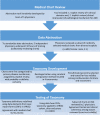The Variation in Recovery: Role of Gender on Outcomes of Young AMI Patients (VIRGO) Classification System: A Taxonomy for Young Women With Acute Myocardial Infarction
- PMID: 26350057
- PMCID: PMC4858327
- DOI: 10.1161/CIRCULATIONAHA.115.016502
The Variation in Recovery: Role of Gender on Outcomes of Young AMI Patients (VIRGO) Classification System: A Taxonomy for Young Women With Acute Myocardial Infarction
Abstract
Background: Current classification schemes for acute myocardial infarction (AMI) may not accommodate the breadth of clinical phenotypes in young women.
Methods and results: We developed a novel taxonomy among young adults (≤55 years) with AMI enrolled in the Variation in Recovery: Role of Gender on Outcomes of Young AMI Patients (VIRGO) study. We first classified a subset of patients (n=600) according to the Third Universal Definition of MI using a structured abstraction tool. There was heterogeneity within type 2 AMI, and 54 patients (9%; including 51 of 412 women) were unclassified. Using an inductive approach, we iteratively grouped patients with shared clinical characteristics, with the aims of developing a more inclusive taxonomy that could distinguish unique clinical phenotypes. The final VIRGO taxonomy classified 2802 study participants as follows: class 1, plaque-mediated culprit lesion (82.5% of women; 94.9% of men); class 2, obstructive coronary artery disease with supply-demand mismatch (2a: 1.4% women; 0.9% men) and without supply-demand mismatch (2b: 2.4% women; 1.1% men); class 3, nonobstructive coronary artery disease with supply-demand mismatch (3a: 4.3% women; 0.8% men) and without supply-demand mismatch (3b: 7.0% women; 1.9% men); class 4, other identifiable mechanism (spontaneous dissection, vasospasm, embolism; 1.5% women, 0.2% men); and class 5, undetermined classification (0.8% women, 0.2% men).
Conclusions: Approximately 1 in 8 young women with AMI is unclassified by the Universal Definition of MI. We propose a more inclusive taxonomy that could serve as a framework for understanding biological disease mechanisms, therapeutic efficacy, and prognosis in this population.
Keywords: classification; myocardial infarction; sex characteristics.
© 2015 American Heart Association, Inc.
Figures
References
-
- Vaccarino V, Parsons L, Every NR, Barron HV, Krumholz HM. Sex-based differences in early mortality after myocardial infarction. National Registry of Myocardial Infarction 2 Participants. N Engl J Med. 1999;341:217–225. - PubMed
-
- Vaccarino V, Horwitz RI, Meehan TP, Petrillo MK, Radford MJ, Krumholz HM. Sex differences in mortality after myocardial infarction: evidence for a sex-age interaction. Arch Intern Med. 1998;158:2054–2062. - PubMed
-
- Hochman JS, McCabe CH, Stone PH, Becker RC, Cannon CP, DeFeo-Fraulini T, Thompson B, Steingart R, Knatterud G, Braunwald E. Outcome and profile of women and men presenting with acute coronary syndromes: a report from TIMI IIIB. TIMI Investigators. Thrombolysis in Myocardial Infarction. J Am Coll Cardiol. 1997;30:141–148. - PubMed
-
- Humphries KH, Pu A, Gao M, Carere RG, Pilote L. Angina with “normal” coronary arteries: sex differences in outcomes. Am Heart J. 2008;155:375–381. - PubMed
Publication types
MeSH terms
Grants and funding
LinkOut - more resources
Full Text Sources
Medical
Molecular Biology Databases




